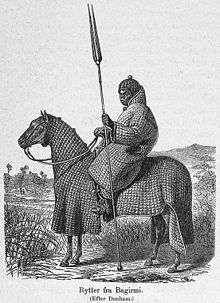Sultanate of Bagirmi
The Sultanate or Kingdom of Bagirmi or Baghermi[1] (French: Royaume du Baguirmi) was a kingdom and Islamic sultanate southeast of Lake Chad in central Africa between 1522 and 1897.
History

_et_le_Kolak_Doudmourrah.jpg)
Mostly contained within modern-day Chad, Bagirmi emerged to the southeast of the Kanem-Bornu Empire under Mbang Birni Besse. He seems to have displaced the earlier Bulala.[2] His state was subjugated by the Bornu Empire by the end of his reign, but continued as a partially independent tributary. The Bagirmi carried a tradition that they migrated from far to the east,[1] which is supported by the resemblance of their language to various tribes on the White Nile.[2] The fourth king, Abdullah (1568–1608), adopted Islam and converted the state into a sultanate, permitting the state to extend their authority over many pagan tribes in the area,[1] including the area's Saras, Gaberi, Somrai, Gulla, Nduka, Nuba, and Sokoro.[2] He and his successors continued to use the title "mbang" alongside that of "sultan". A palace and court were eventually constructed in Bagirmi's capital Massenya.
The Shari River formed the kingdom's western boundary, with most of its interior watered by its affluents.[1] The area was home to a kind of footworm that mutilated many of the inhabitants.[1] Bagirmi was also continually plagued by drought, pestilence,[1] and slave raiding both internally[1] and externally[2] organized. The Muslim Bagirmi would raid the pagan tribes of their own kingdom in order to pay the necessary tribute to Bornu.[1] Trade with Bornu was carried out by caravan along a route which extended north across the Sahara to Tripoli on the Libyan coast.[2]
Bagirmi's political history was a function of its strength and unity in relation to its larger neighbors. Absorbed into Kanem-Bornu during the reign of Idris Alooma, Bagirmi broke free later in the 17th century, only to be returned to tributary status in the mid-18th century. During periods of strength, the sultanate became imperialistic. It established control over small feudal kingdoms on its peripheries and entered into alliances with nearby nomadic peoples.
Early in the 19th century, Bagirmi fell into decay and was threatened by the Sultanate of Wadai. It was finally annexed in 1871.[2] It came to European attention following the visits of Dixon Denham (1823), Heinrich Barth (1852), Gustav Nachtigal (1872), and Matteucci and Massari (1881).[2] When Rabih az-Zubayr's forces burned Massenya in 1893, the 25th sultan, Abd ar Rahman Gaourang, moved his government to Chekna.[2] During the Scramble for Africa, the Third French Republic became interested in connecting its possessions across the breadth of Africa, permitting a Dakar–Djibouti railway. Rabih killed Paul Crampel, the leader of the first French expedition through the area but Emile Gentil secured a protectorate over Bagirmi from its sultan in 1897.[2] French ambitions in the Sudan were blocked following the Fashoda Crisis the next year, and their authority over the Bagirmi itself was not secured until after the death of Rabih and his sons in 1901.[2][n 1] Towns grew up around the French Fort Lamy at the confluence of the Logone and Shari and Fort de Cointet on the middle Shari.[2] The population of the district was reckoned as 100,000 in 1903 and, by the time of the First World War, most of its trade was being conducted with Khartoum in Sudan through the Wadai Empire and with Yola in Nigeria along the Benue.[2]
Legacy
The Baguirmi language is still spoken today, with 44,761 speakers as of 1993, primarily in the Chari-Baguirmi Region. The empire now exists as an informal entity in the Baguirmi Department, with its capital at Massenya. Its rulers continue to bear the title "Mbang".
See also
Notes
References
Citations
Bibliography
- "Baghermi", Encyclopædia Britannica, 9th ed., Vol. III, New York: Charles Scribner's Sons, 1878, p. 234.
- "Bagirmi", Encyclopædia Britannica, 11th ed., Vol. III, Cambridge: Cambridge University Press, 1911, p. 201.
- Lebeuf, Annie M.D. (1978), "L'ancien royaume du Baguirmi", Mondes et Cultures, Vol. 38, No. 3, pp. 437–443. (French)
- N'Gare, Ahmed (1997), "Le royaume du Baguirmi (XVe–XXe siècles)", Hemispheres, No. 11, pp. 27–31. (French)
External links
- "Chad", Country Studies, Washington: Library of Congress.